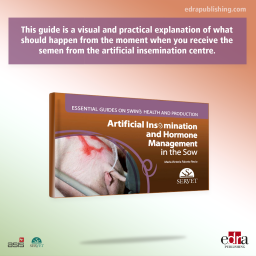






This guide is a visual and practical explanation of what should happen from the moment when you receive the semen from the artificial insemination centre, until the moment when the sow is inseminated, with a focus on the use of refrigerated semen: conservation and management of seminal doses, oestrus detection, identification of the best time for insemination, insemination methods, and hormonal control of oestrus and ovulation.
This guide is a visual and practical explanation of what should happen from the moment when you receive the semen from the artificial insemination centre, until the moment when the sow is inseminated, with a focus on the use of refrigerated semen: conservation and management of seminal doses, oestrus detection, identification of the best time for insemination, insemination methods, and hormonal control of oestrus and ovulation.
Author
María Victoria Falceto Recio
María Victoria Falceto Recio is professor of Reproduction and Obstetrics at the Faculty of Veterinary Medicine of the University of Zaragoza (UZ) and academic coordinator of Pig Production as part of the undergraduate programme in veterinary medicine. She has been head of the Reproductive Consultancy Service at the Faculty of Veterinary Medicine (UZ) since 2003, and codirector of the Joint Master’s Degree Programme in Pig Health and Production organised by the universities of Lleida, Zaragoza, Barcelona and Madrid since 2006. She has authored or coauthored numerous scientific articles published in Spanish and international journals and is the author of the handbook Essential guides on swine health and production. Ovarian pathophysiology in the sow, published by Servet. María Victoria has vast experience in the pig production industry, both from an academic and scientific perspective, as well as from a practical one. For this reason, she is secretary of the Spanish Association of Swine Veterinary Practitioners (ANAVEPOR), a member of the Board of Directors of the Aragon Association of Swine Veterinary Practitioners (AVPA) and a member of the Spanish Scientific Pig Farming Association (ANAPORC).
Table of Contents
1. AI in pigs: current approach
2. Oestrus detection in the sow
Oestrous cycle
Signs of oestrus
Detection of oestrus
Consequences of poor oestrus detection
3. Timing of artificial insemination
When to inseminate
Insemination based on estimating the moment of ovulation
Fixed-time artificial insemination
When to stop inseminating
4. Methodology of artificial insemination
Preparation of the semen
Preparing the equipment required for artificial insemination
Common features of all AI techniques
Intracervical insemination
Postcervical intrauterine insemination
Deep intrauterine insemination
Use of seminal additives during artificial insemination
5. Hormonal control of oestrus
Induction of oestrus
Synchronising oestrus
Induction and synchronisation of ovulation
Data sheet
Specific References